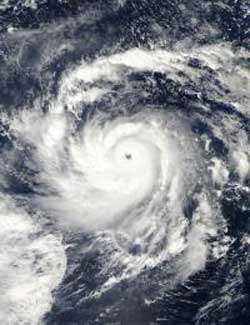NASA's Aqua satellite sees Nida explode into a category 5 Super Typhoon

The MODIS instrument on NASA\'s Aqua satellite captured a visible image of Super Typhoon Nida early on Nov. 25 that shows a perfectly symmetrical storm and a clear eye, both hallmarks of a powerful typhoon. Credit: NASA MODIS Rapid Response Team <br>
The Moderate Imaging Spectroradiometer or MODIS instrument that flies aboard NASA's Aqua satellite captured a visible image of Super Typhoon Nida on November 25 at 0355 UTC (November 24 at 10:55 p.m. ET). The image clearly revealed an eye that showed the surface of the northwestern Pacific Ocean! The MODIS image showed a tightly circulating symmetrical hurricane form.
At 10 a.m. ET on November 25, Super Typhoon Nida had maximum sustained winds near 172 mph (150 knots) with gusts as high as 207 mph! A category five typhoon on the Saffir-Simpson scale has sustained winds greater than 155 mph. Typhoon-force winds extend as far as 45 miles from Nida's center, while tropical storm-force winds extend out as far as 105 miles from Nida's center.
Nida was about 155 miles west-southwest of Guam, near 12.6 North latitude and 142.2 East longitude. It was moving to the northwest near 15 mph, and its powerful winds were kicking up dangerously high waves up to 44 feet high!
Fortunately, no landmasses are directly threatened by Nida, although today, Nida is passing between the island of Yap and Andersen Air Force Base. Those islands will experience heavy surf to their northeastern and southwestern sides, respectively. The Joint Typhoon Warning Center noted that Nida can strengthen even further as it is going to track over very warm sea surface temperatures in the next day.
Nida is forecast to remain in open waters over the next 5 days and is expected to pass far to the southwest of the island of Iwo Two on Monday, November 30.
Media Contact
More Information:
http://www.nasa.govAll latest news from the category: Physics and Astronomy
This area deals with the fundamental laws and building blocks of nature and how they interact, the properties and the behavior of matter, and research into space and time and their structures.
innovations-report provides in-depth reports and articles on subjects such as astrophysics, laser technologies, nuclear, quantum, particle and solid-state physics, nanotechnologies, planetary research and findings (Mars, Venus) and developments related to the Hubble Telescope.
Newest articles

A universal framework for spatial biology
SpatialData is a freely accessible tool to unify and integrate data from different omics technologies accounting for spatial information, which can provide holistic insights into health and disease. Biological processes…

How complex biological processes arise
A $20 million grant from the U.S. National Science Foundation (NSF) will support the establishment and operation of the National Synthesis Center for Emergence in the Molecular and Cellular Sciences (NCEMS) at…

Airborne single-photon lidar system achieves high-resolution 3D imaging
Compact, low-power system opens doors for photon-efficient drone and satellite-based environmental monitoring and mapping. Researchers have developed a compact and lightweight single-photon airborne lidar system that can acquire high-resolution 3D…





















